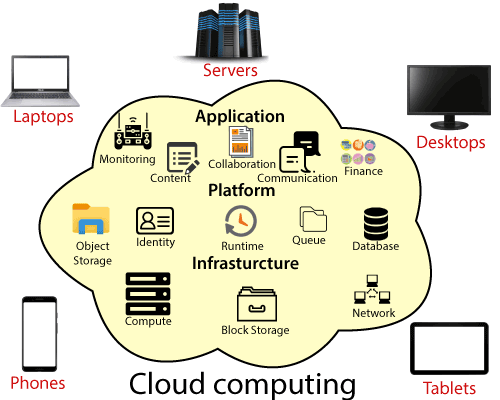Nowadays, Cloud computing is adopted by every company, whether it is an MNC or a startup many are still migrating towards it because of the cost-cutting, lesser maintenance, and the increased capacity of the data with the help of servers maintained by the cloud providers.
One more reason for this drastic change from the On-premises servers of the companies to the Cloud providers is the ‘Pay as you go’ principle-based services provided by them i.e., you only have to pay for the service which you are using.
What Is Cloud Computing?
Cloud Computing means storing and accessing the data and programs on remote servers that are hosted on the internet instead of the computer’s hard drive or local server. Cloud computing is also referred to as Internet-based computing, it is a technology where the resource is provided as a service through the Internet to the user. The data that is stored can be files, images, documents, or any other storable document.
OR
Cloud computing is a technology to store, manage, process, and access the data over the internet instead of a local server or computer hard drives. Here, the term cloud is taken from the symbol of the internet users in the flowcharts. The remote servers are used in cloud computing to store the data that can be accessed from anywhere using the internet.
With the help of cloud computing, an organization can save lots of cost of local data storage, maintenance of data, etc. The information over the cloud can be accessed by anyone, anywhere, and anytime, with the help of the internet.
Using cloud computing instead of traditional storage helps users with lots of benefits such as speed, cost-effectiveness, security, global access, etc.
The following are some of the Operations that can be performed with Cloud Computing
- Storage, backup, and recovery of data
- Delivery of software on demand
- Development of new applications and services
- Streaming videos and audio
OR
Cloud Computing is the delivery of computing services such as servers, storage, databases, networking, software, analytics, intelligence, and more, over the Cloud (Internet).

Cloud Computing provides an alternative to the on-premises datacentre. With an on-premises datacentre, we have to manage everything, such as purchasing and installing hardware, virtualization, installing the operating system, and any other required applications, setting up the network, configuring the firewall, and setting up storage for data. After doing all the set-up, we become responsible for maintaining it through its entire lifecycle.
But if we choose Cloud Computing, a cloud vendor is responsible for the hardware purchase and maintenance. They also provide a wide variety of software and platform as a service. We can take any required services on rent. The cloud computing services will be charged based on usage.

The cloud environment provides an easily accessible online portal that makes handy for the user to manage the compute, storage, network, and application resources. Some cloud service providers are in the following figure.

Understanding How Cloud Computing Works?
Cloud computing helps users in easily accessing computing resources like storage, and processing over internet rather than local hardwares. Here we discussing how it works in nutshell:
- Infrastructure: Cloud computing depends on remote network servers hosted on internet for store, manage, and process the data.
- On-Demand Acess: Users can access cloud services and resources based on-demand they can scale up or down the without having to invest for physical hardware.
- Types of Services: Cloud computing offers various benefits such as cost saving, scalability, reliability and acessibility it reduces capital expenditures, improves efficiency.